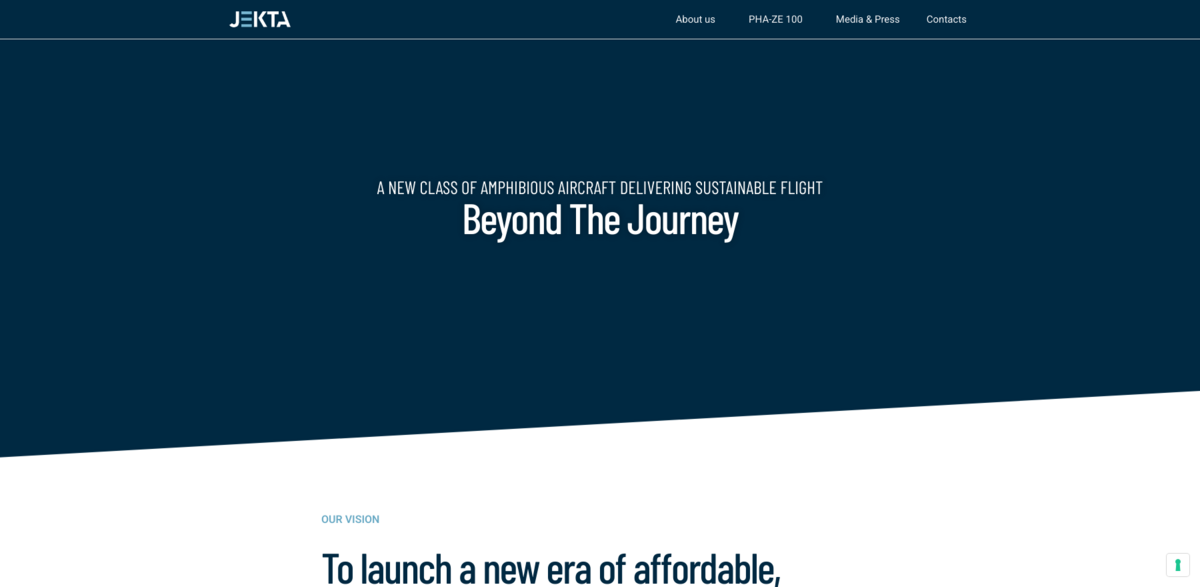What is the Jekta Project?
The Jekta project is all about launching a new era of affordable, sustainable regional air mobility. At its core, it’s focused on creating a new class of amphibious aircraft that deliver sustainable flight — and doing so as a global leader in this niche. The star of the show? The PHA-ZE 100, a passenger hydroaircraft that generates zero emissions right at the source. This isn’t just a concept; it’s a regional amphibious aircraft designed to minimize costs and infrastructure needs, making air travel more accessible and eco-friendly. The team behind Jekta isn’t new to this game either — they’ve already developed traditional amphibious airframes seating two to eight passengers, and now they’re taking it electric.
Main Benefits of the PHA-ZE 100
The PHA-ZE 100 packs a punch with its innovative features and impressive specs. Here’s a quick rundown:
- Electric propulsion system
- Battery blocks combined with hydrogen fuel cells
- Capacity for up to 19 passengers plus 3 crew members
- Multiple cabin configurations to suit different needs
- Operates from water, paved, and unpaved runways
- Compliance with Europe CS23 and USA FAR-23 standards
- Can handle waves up to 1.2 meters in height
- Cruising speed of 110 knots, with a stall speed (VSO) of 50 knots
- Technical flight altitude up to 13,700 feet (4,500 meters)
Looking Back to Move Forward
Jekta’s approach is pretty fascinating — they’ve looked back to the golden age of amphibious aircraft to inspire a future that truly shines. It’s not just about technology; it’s about redefining the class with a zero-emissions regional aircraft that opens up new markets, supports existing routes, and ultimately provides access to aviation for more people around the world. This blend of nostalgia and innovation creates a unique position for Jekta in the aviation industry.
The Big Vision: Scaling Up
While the PHA-ZE 100 is the current flagship, Jekta’s ambitions don’t stop there. The company envisions a 100-seat amphibious aircraft within the next 10 to 15 years. This isn’t just a pipe dream — it’s a strategic goal aimed at expanding the reach and impact of sustainable seaplanes, serving both developed and developing regions alike. The idea is to enhance global air transport networks with next-generation aircraft that are as versatile as they are eco-friendly.
Jekta’s Background and Expertise
What sets Jekta apart is the depth of experience behind the project. The executive team has a proven track record of designing, certifying, manufacturing, and selling conventional amphibious airframes. This wealth of knowledge is now being channeled into electric airframes, combining decades of manufacturing expertise with a commitment to supporting aircraft operators. It’s a seamless transfer of legacy skills into cutting-edge technology — a continuation of the seaplane spirit, but with a modern, sustainable twist.
Project Impact: Sustainable Development Goals (SDGs)
- SDG 7: Affordable and Clean Energy
- SDG 9: Industry, Innovation, and Infrastructure
- SDG 11: Sustainable Cities and Communities
- SDG 12: Responsible Consumption and Production
- SDG 13: Climate Action
Core Values Driving Jekta
At the heart of Jekta’s mission are five core values that guide every step of the journey: innovation, customer focus, transparency, sustainability, and quality. These principles aren’t just buzzwords — they shape the way the company designs, builds, and supports its aircraft. The commitment to sustainability, in particular, is a driving force behind the shift to electric propulsion and the goal of reducing aviation’s ecological footprint. It’s about honoring the legacy of amphibious aircraft while pushing the boundaries of what’s possible in modern aviation.





















